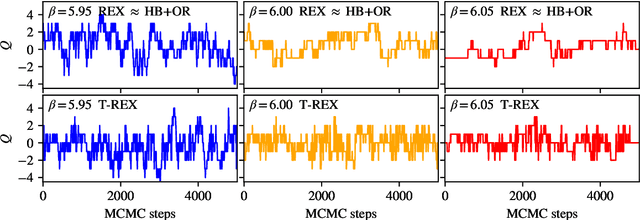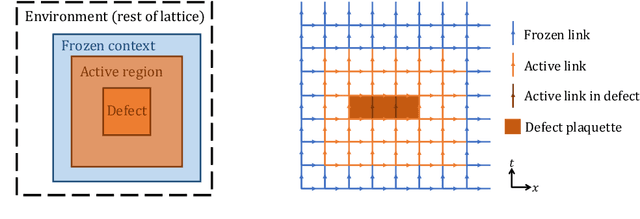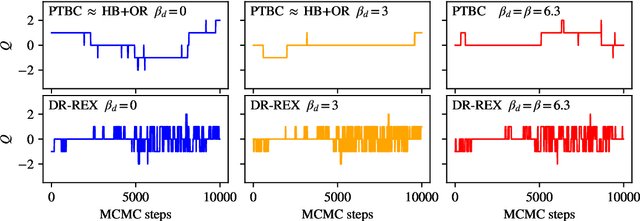Michael S. Albergo
NETS: A Non-Equilibrium Transport Sampler
Oct 03, 2024Abstract:We propose an algorithm, termed the Non-Equilibrium Transport Sampler (NETS), to sample from unnormalized probability distributions. NETS can be viewed as a variant of annealed importance sampling (AIS) based on Jarzynski's equality, in which the stochastic differential equation used to perform the non-equilibrium sampling is augmented with an additional learned drift term that lowers the impact of the unbiasing weights used in AIS. We show that this drift is the minimizer of a variety of objective functions, which can all be estimated in an unbiased fashion without backpropagating through solutions of the stochastic differential equations governing the sampling. We also prove that some these objectives control the Kullback-Leibler divergence of the estimated distribution from its target. NETS is shown to be unbiased and, in addition, has a tunable diffusion coefficient which can be adjusted post-training to maximize the effective sample size. We demonstrate the efficacy of the method on standard benchmarks, high-dimensional Gaussian mixture distributions, and a model from statistical lattice field theory, for which it surpasses the performances of related work and existing baselines.
Flow Map Matching
Jun 11, 2024Abstract:Generative models based on dynamical transport of measure, such as diffusion models, flow matching models, and stochastic interpolants, learn an ordinary or stochastic differential equation whose trajectories push initial conditions from a known base distribution onto the target. While training is cheap, samples are generated via simulation, which is more expensive than one-step models like GANs. To close this gap, we introduce flow map matching -- an algorithm that learns the two-time flow map of an underlying ordinary differential equation. The approach leads to an efficient few-step generative model whose step count can be chosen a-posteriori to smoothly trade off accuracy for computational expense. Leveraging the stochastic interpolant framework, we introduce losses for both direct training of flow maps and distillation from pre-trained (or otherwise known) velocity fields. Theoretically, we show that our approach unifies many existing few-step generative models, including consistency models, consistency trajectory models, progressive distillation, and neural operator approaches, which can be obtained as particular cases of our formalism. With experiments on CIFAR-10 and ImageNet 32x32, we show that flow map matching leads to high-quality samples with significantly reduced sampling cost compared to diffusion or stochastic interpolant methods.
Practical applications of machine-learned flows on gauge fields
Apr 17, 2024



Abstract:Normalizing flows are machine-learned maps between different lattice theories which can be used as components in exact sampling and inference schemes. Ongoing work yields increasingly expressive flows on gauge fields, but it remains an open question how flows can improve lattice QCD at state-of-the-art scales. We discuss and demonstrate two applications of flows in replica exchange (parallel tempering) sampling, aimed at improving topological mixing, which are viable with iterative improvements upon presently available flows.
Probabilistic Forecasting with Stochastic Interpolants and Föllmer Processes
Mar 20, 2024Abstract:We propose a framework for probabilistic forecasting of dynamical systems based on generative modeling. Given observations of the system state over time, we formulate the forecasting problem as sampling from the conditional distribution of the future system state given its current state. To this end, we leverage the framework of stochastic interpolants, which facilitates the construction of a generative model between an arbitrary base distribution and the target. We design a fictitious, non-physical stochastic dynamics that takes as initial condition the current system state and produces as output a sample from the target conditional distribution in finite time and without bias. This process therefore maps a point mass centered at the current state onto a probabilistic ensemble of forecasts. We prove that the drift coefficient entering the stochastic differential equation (SDE) achieving this task is non-singular, and that it can be learned efficiently by square loss regression over the time-series data. We show that the drift and the diffusion coefficients of this SDE can be adjusted after training, and that a specific choice that minimizes the impact of the estimation error gives a F\"ollmer process. We highlight the utility of our approach on several complex, high-dimensional forecasting problems, including stochastically forced Navier-Stokes and video prediction on the KTH and CLEVRER datasets.
SiT: Exploring Flow and Diffusion-based Generative Models with Scalable Interpolant Transformers
Jan 16, 2024Abstract:We present Scalable Interpolant Transformers (SiT), a family of generative models built on the backbone of Diffusion Transformers (DiT). The interpolant framework, which allows for connecting two distributions in a more flexible way than standard diffusion models, makes possible a modular study of various design choices impacting generative models built on dynamical transport: using discrete vs. continuous time learning, deciding the objective for the model to learn, choosing the interpolant connecting the distributions, and deploying a deterministic or stochastic sampler. By carefully introducing the above ingredients, SiT surpasses DiT uniformly across model sizes on the conditional ImageNet 256x256 benchmark using the exact same backbone, number of parameters, and GFLOPs. By exploring various diffusion coefficients, which can be tuned separately from learning, SiT achieves an FID-50K score of 2.06.
Learning to Sample Better
Oct 17, 2023Abstract:These lecture notes provide an introduction to recent advances in generative modeling methods based on the dynamical transportation of measures, by means of which samples from a simple base measure are mapped to samples from a target measure of interest. Special emphasis is put on the applications of these methods to Monte-Carlo (MC) sampling techniques, such as importance sampling and Markov Chain Monte-Carlo (MCMC) schemes. In this context, it is shown how the maps can be learned variationally using data generated by MC sampling, and how they can in turn be used to improve such sampling in a positive feedback loop.
Multimarginal generative modeling with stochastic interpolants
Oct 05, 2023Abstract:Given a set of $K$ probability densities, we consider the multimarginal generative modeling problem of learning a joint distribution that recovers these densities as marginals. The structure of this joint distribution should identify multi-way correspondences among the prescribed marginals. We formalize an approach to this task within a generalization of the stochastic interpolant framework, leading to efficient learning algorithms built upon dynamical transport of measure. Our generative models are defined by velocity and score fields that can be characterized as the minimizers of simple quadratic objectives, and they are defined on a simplex that generalizes the time variable in the usual dynamical transport framework. The resulting transport on the simplex is influenced by all marginals, and we show that multi-way correspondences can be extracted. The identification of such correspondences has applications to style transfer, algorithmic fairness, and data decorruption. In addition, the multimarginal perspective enables an efficient algorithm for reducing the dynamical transport cost in the ordinary two-marginal setting. We demonstrate these capacities with several numerical examples.
Stochastic interpolants with data-dependent couplings
Oct 05, 2023



Abstract:Generative models inspired by dynamical transport of measure -- such as flows and diffusions -- construct a continuous-time map between two probability densities. Conventionally, one of these is the target density, only accessible through samples, while the other is taken as a simple base density that is data-agnostic. In this work, using the framework of stochastic interpolants, we formalize how to \textit{couple} the base and the target densities. This enables us to incorporate information about class labels or continuous embeddings to construct dynamical transport maps that serve as conditional generative models. We show that these transport maps can be learned by solving a simple square loss regression problem analogous to the standard independent setting. We demonstrate the usefulness of constructing dependent couplings in practice through experiments in super-resolution and in-painting.
Normalizing flows for lattice gauge theory in arbitrary space-time dimension
May 03, 2023



Abstract:Applications of normalizing flows to the sampling of field configurations in lattice gauge theory have so far been explored almost exclusively in two space-time dimensions. We report new algorithmic developments of gauge-equivariant flow architectures facilitating the generalization to higher-dimensional lattice geometries. Specifically, we discuss masked autoregressive transformations with tractable and unbiased Jacobian determinants, a key ingredient for scalable and asymptotically exact flow-based sampling algorithms. For concreteness, results from a proof-of-principle application to SU(3) lattice gauge theory in four space-time dimensions are reported.
Stochastic Interpolants: A Unifying Framework for Flows and Diffusions
Mar 27, 2023Abstract:A class of generative models that unifies flow-based and diffusion-based methods is introduced. These models extend the framework proposed in Albergo & Vanden-Eijnden (2023), enabling the use of a broad class of continuous-time stochastic processes called `stochastic interpolants' to bridge any two arbitrary probability density functions exactly in finite time. These interpolants are built by combining data from the two prescribed densities with an additional latent variable that shapes the bridge in a flexible way. The time-dependent probability density function of the stochastic interpolant is shown to satisfy a first-order transport equation as well as a family of forward and backward Fokker-Planck equations with tunable diffusion. Upon consideration of the time evolution of an individual sample, this viewpoint immediately leads to both deterministic and stochastic generative models based on probability flow equations or stochastic differential equations with an adjustable level of noise. The drift coefficients entering these models are time-dependent velocity fields characterized as the unique minimizers of simple quadratic objective functions, one of which is a new objective for the score of the interpolant density. Remarkably, we show that minimization of these quadratic objectives leads to control of the likelihood for any of our generative models built upon stochastic dynamics. By contrast, we establish that generative models based upon a deterministic dynamics must, in addition, control the Fisher divergence between the target and the model. We also construct estimators for the likelihood and the cross-entropy of interpolant-based generative models, discuss connections with other stochastic bridges, and demonstrate that such models recover the Schr\"odinger bridge between the two target densities when explicitly optimizing over the interpolant.
 Add to Chrome
Add to Chrome Add to Firefox
Add to Firefox Add to Edge
Add to Edge